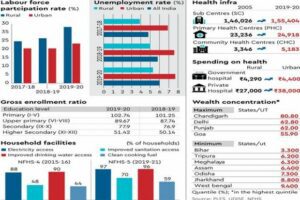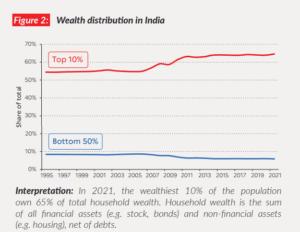The State of Inequality in India Report
Context:
- The State of Inequality in India Report was released today by Dr Bibek Debroy, Chairman, Economic Advisory Council to the Prime Minister (EAC-PM).
- The report has been written by the Institute for Competitiveness and presents a holistic analysis of the depth and nature of inequality in India.
About the report:
- The report looks at five main factors that determine the nature and experience of inequality. It is divided into two parts: Economic Facets and Socio-Economic Manifestations.
- Income distribution and labour market dynamics, as well as health, education, and household characteristics, are among them.
- Each chapter is dedicated to explaining the current state of affairs, areas of concern, successes and failures in terms of infrastructural capacity, and finally, the effect on inequality, using data from various rounds of the Periodic Labour Force Survey (PLFS), National Family and Health Survey (NFHS), and UDISE+.
- UDISE+ : Unified District Information System for Education (UDISE) initiated in 2012-13 integrating DISE for elementary and secondary education is one of the largest Management Information Systems on School Education covering more than 1.5 million schools, more then 9.6 million teachers and more then 264 million children.
- UDISE+ is an updated and improved version of UDISE. The entire system is now online and has been collecting data in real-time since 2018-19.

Status of Wealth, Health & Education:
- The paper goes beyond wealth projections, which only provide a partial view, to emphasise income distribution forecasts for the years 2017-18, 2018-19, and 2019-20.
- The paper emphasises that wealth concentration as a measure of inequality does not disclose changes in household purchasing power, and instead focuses for the first time on income distribution to understand capital movement.
- There has been significant progress in increasing health infrastructure capacity, with a particular focus on rural areas. In 2005, there were 1,72,608 total health centres in India; by 2020, there would be 1,85,505.
- According to the report, education and household conditions have improved enormously due to targeted efforts through several social protection schemes, especially in the area of water availability and sanitation that have increased the standard of living.

Source: THE HINDU.
For more update, click here to join our telegram channel




